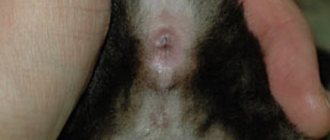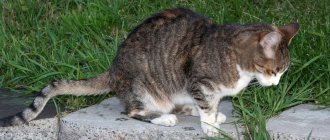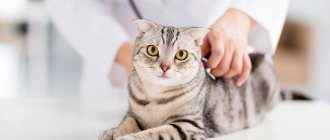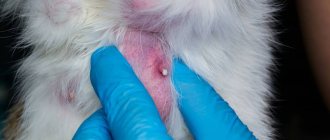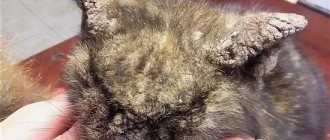Cats, like people, can get colds; they are caused by viruses and microbes that live and multiply in the respiratory organs. Colds rarely occur in cats; normally, the animal’s body is able to cope with the pathogen, but under certain conditions the cat can catch a cold.
The symptoms of a cold in cats are very similar to those in humans, so owners often wonder whether a cat can get it from a person. As a rule, a cold is a viral disease; the virus that causes ARVI in a cat cannot be dangerous to people. A cat can catch a cold from a person only if the disease is caused by a microbial agent to which the pet is sensitive. In other cases, a person’s cold may not be a cause for concern for the pet’s health.
Do not forget about other pets living with a sick cat; they can become infected, so it is recommended to isolate them from each other.
Why does a cat get a cold?
A cold occurs in a cat as a result of hypothermia. During contact with cold, due to drafts, the pet’s immune system malfunctions. This creates the most favorable environment for the attack of viruses and microbes. In addition to hypothermia, there are other factors that contribute to the occurrence of colds, the most common among them:
- Weakening of the immune system due to previous diseases.
- Walking in the rain and wind.
- Finding an animal in drafts.
- Change of usual food.
- Unvaccinated animals with chronic diseases suffer from colds more often.
How can you get sick
As mentioned above, the key aspects of a cold can be considered hypothermia, weakened immunity and viral infection. Hence the risk factors that dramatically increase the likelihood of a kitten catching a cold.
- Hypothermia. That is, prolonged exposure to the cold - for example, outside in winter, during rain, strong cold wind, etc. Keeping a cat in a damp, cold room can also lead to this.
Read more about the dangers of cold: Dangers of Cold for Cats
- Separately, it is worth mentioning the possibility of hypothermia during or after swimming. Even a temperature difference of a few degrees can cause your kitten to catch a cold. Therefore, if you decide to bathe your pet, be especially attentive to the room temperature (the optimal range for cats is considered to be from +18 to +24), avoid drafts, immediately after bathing, wrap tightly in a towel and keep it there until the fur dries.
Read more about bathing cats: Should you wash your cat?
- Drafts themselves can lead to a cold. Especially in autumn and spring - when the temperature outside is already or still low (but sufficient for people to want to ventilate the room), and there is no heating.
- Previous infections increase the risk of developing a new disease. The disease causes the immune system to weaken and the body to become more vulnerable for some time. Without proper care, the risk of re-infection increases.
- An unbalanced diet, a deficiency of vitamins and nutrients in the body lead to a decrease in immunity and a weakening of protective functions. As a result, it becomes easier for various pathogens to gain a foothold and begin to multiply.
Treating a cat for sneezing
Only a veterinary specialist at the clinic can prescribe the correct treatment for a cat with symptoms of sneezing. If, during a clinical examination of your cat, a veterinarian determines that your cat is clinically healthy, he will recommend that you wet clean your apartment and use a special humidifier.
If the cause of sneezing is allergic in nature, then recommendations will be given to eliminate the allergen present in the apartment or to ensure that household chemicals are inaccessible to your cat. In order to alleviate the condition, a veterinarian will prescribe one or another antihistamine to your animal.
Diagnostics
Diagnosis first of all begins with a clinical examination by a veterinarian-therapist, who carefully examines the animal, assessing the severity of the general condition. Based on the results of the initial examination, additional diagnostic procedures are prescribed, such as blood tests, virological studies (it is possible to conduct rapid tests for some respiratory infections), and x-ray diagnostics. An accurate diagnosis is made only in the aggregate of all diagnostic results.
The main laboratory diagnostics are a clinical blood test, ELISA and PCR diagnostics, which make it possible to find out both general nonspecific changes in the animal’s condition and to accurately determine the causative agent of the disease and select the right treatment.
Possible consequences of a cold
It can be difficult for cat owners to understand that the disease is not typical for a small predator, and the complications, if left untreated, are extremely dangerous. A cat's illness rarely poses a danger to the human body, but can be transmitted to other four-legged and feathered inhabitants of the apartment.
If you ignore the primary symptoms and do not start treatment in time, the disease progresses to a serious stage.
Typical complications:
- bronchitis,
- pneumonia,
- joint damage,
- genitourinary infections.
Also, the immune system weakened by the disease is a poor “protector” for the animal. Viruses brought by the owner on street clothes and shoes can easily infect a sick body.
What is otitis media
Otitis is the general name for inflammatory processes in the ear area.
Inflammation can be acute or chronic, affecting various parts of the ear. If the inflammation is localized in the auricle and ear canal to the border of the eardrum, this is otitis externa; inflammation in the tympanic cavity is otitis media; if the area of the cochlea is affected, the inner part of the ear is internal otitis or labyrinthitis.
These pathologies are extremely painful, accompanied by fever, hearing impairment, and discharge from the external meatus. In addition, without treatment, otitis media can lead to serious complications - hearing loss or complete deafness, paresis in the area of the facial nerve, damage to the bones or brain.
How does a cold manifest in cats?
Colds in cats. The symptoms of viral diseases in cats are similar, however, successful treatment is only possible with the correct diagnosis. Therefore, when your pet shows signs of a cold, you should urgently consult a specialist. Tests may be needed to determine the virus that causes the illness. Colds are more common in kittens due to their rather weak immunity. The main symptoms include:
- increased body temperature (nose becomes dry and hot)
- lack of appetite
- runny nose and sneezing
- heavy breathing, cough
- tearfulness
- apathy, etc.
Symptoms
The clinical picture of a viral infection and a cold is easy to confuse; the symptoms are almost the same.
Sick beast:
- feels weak, constantly lies down, stops playing;
- loses interest in his surroundings;
- practically stops eating;
- has difficulty breathing;
- begins to cough, sneeze;
- discharge appears from the sinuses;
- lacrimation is observed;
- the nasal mucosa becomes hot and dry;
- body temperature rises.
Be sure to read:
Immunodeficiency in cats: description, stages, symptoms, how to treat, what is FIV, is it dangerous?
The clinical picture of a viral infection can be complemented by the following signs:
- the lymph nodes located under the jaw increase in size;
- the nasal sinuses become covered with a white coating;
- the cat has difficulty eating and drinking water;
- Ulcers form on the mucous membranes of the lips, tongue, and eyes.
The cat has a cold and is sneezing: what to do?
If your pet is sneezing, coughing, the nose is dry and hot, the eyes are watery, there is no appetite, breathing is difficult, you should give the cat first aid.
Algorithm of actions:
- Carry out a visual inspection, analyze whether the disease is the result of a viral infection.
- Place the sick person in a comfortable, warm place, making sure there are no drafts.
- Put a heating pad on if the animal is cold.
- Give plenty of warm water and milk. Cold drinks are prohibited.
- Massage your body to increase blood circulation.
- Offer nutritious food.
If after two or three days the pet’s condition remains unchanged, you must visit a veterinary clinic, where the doctor will make an accurate diagnosis.
ARVI and immunity
According to the World Health Organization, ARVI ranks first in the structure of morbidity among young children. There are a large number of viruses that cause ARVI. These include: influenza viruses, parainfluenza, respiratory syncytial viruses, adenovirus, ECHO viruses, Coxsackie viruses, rhinoviruses, reoviruses, coronaviruses. The high incidence of ARVI is associated with unstable immunity in children after previous ARVI, as well as the high prevalence of these viruses. In unfavorable environmental conditions, acute respiratory viral infections predetermine even greater changes in immunity, especially in young children. This can lead to significant changes in the formation of the baby’s immunity, as well as contribute to the development of chronic diseases of various systems of the child’s body at an older age. Considering the high prevalence of ARVI, the issue of treating children with this pathology remains relevant. We will approach the treatment of colds from the point of view of modern protocols for the treatment of ARVI in children, which were developed by the Russian Union of Pediatricians. Before moving on to considering children's medications for colds and flu, it is necessary to understand the main manifestations of ARVI in children.
It is important to monitor the child’s condition and contact a pediatrician at the first symptoms of a cold.
Prevention
A cold is not dangerous for an animal with normal immunity, but the disease causes discomfort to the cat and is quite difficult to treat. It is much easier to prevent infection. The following measures help with this:
- Proper care of animals. For the first few weeks of life, kittens should be kept in a warm, draft-free room. Trays and sleeping places for adult animals should also not be in rooms with cold air.
- Gradual adaptation to the street. You need to start this procedure in the warm season. The cat is allowed outside for several hours. In this case, you need to ensure that the animal does not become hypothermic. In rainy and windy weather, walks are avoided.
- Proper bathing. The cat needs to be bathed with warm water. After the procedure, the fur is thoroughly dried with a towel, while the pet should be in a warm room.
- Proper nutrition. The diet should include balanced food and sufficient fluids. Do not give your cat cold food or water.
Modern methods of treatment
We asked otolaryngologist Svetlana Komarova to talk about how otitis in adults is treated today. According to her, drug therapy may include:
- drops in the ear containing the analgesic Phenazone and the local anesthetic Lidocaine - to relieve pain and reduce inflammation, if discharge from the ear appears, antibacterial drops containing Rifampicin or Ciprofloxacin should be used;
- vasoconstrictor drops containing Xylometazoline 0.1%, Oxymetazoline 0.05%, Naphazoline 0.1%, Phenylephrine 0.025% are instilled into the nose to reduce swelling of the nasopharyngeal mucosa around the mouth of the auditory tubes;
- if local drugs are ineffective, analgesics and non-steroidal anti-inflammatory drugs (Acetylsalicylic acid, Paracetamol, Tramadol, Ketoprofen, Ibuprofen) are prescribed orally;
- antipyretic drugs (Paracetamol) are used when the temperature rises above 38.5 C;
- antihistamines (Diphenhydramine, Clemastine, Chloropyramine) are prescribed to reduce swelling;
- broad-spectrum antibacterial drugs: penicillins, cephalosporins, macrolides, respiratory fluoroquinolones.
Non-drug treatment methods:
- procedures prescribed by an otolaryngologist: lavage of the external auditory canal, catheterization of the auditory tube, blowing of the auditory tubes according to Politzer, pneumomassage of the eardrum;
- physiotherapy: ultraviolet irradiation, UHF, microwave therapy, electrophoresis with anti-inflammatory drugs as prescribed by a physiotherapist.
Non-drug treatment methods help relieve pain, restore hearing and prevent complications.
In case of complicated otitis or the ineffectiveness of conservative therapy, surgical treatment (myringotomy, bypass of the tympanic cavity, radical surgery on the middle ear) is indicated, aimed at sanitizing the source of infection, restoring hearing, and preventing relapses.
Symptoms
Before making a final diagnosis, your veterinarian must rule out other feline infections.
- Deterioration of general condition. The animal is weak, but at the same time it can move and leave the bed. A complete lack of activity in a cat signals a more serious pathological process in the body.
- Nasal discharge. The multiplication of viruses in the respiratory tract causes inflammatory processes. Nasal discharge is a protective reaction and allows the animal to get rid of the virus. When you have a cold, the discharge is clear, without any admixture of pus or blood. Changes in the nature of nasal discharge indicate that this is not a cold, but a more serious disease that requires immediate treatment under the supervision of a specialist. In the case when nasal breathing is preserved, we can talk about treating colds in cats; if the discharge does not allow breathing through the nose at all, then this signals another disease.
- Sneezing and coughing. This is another way to clear mucus from the airways.
- Discharge from the eyes. The symptom is quite rare, with severe irritation of the mucous membranes. From the outside it looks like the cat's eyes are watering.
- Decreased appetite. When an animal has a cold, it does not completely refuse food, but the amount of food consumed is significantly reduced. This is due to the weakness of the pet.
- Fever.
When should a sick person see a doctor?
A healthy body can and should overcome a mild ARVI that occurs without serious symptoms in 5–7 days. If within a week the symptoms do not go away or even worsen, we can almost certainly talk about a complication of a seemingly unimportant disease.
The patient may experience symptoms of laryngitis or pharyngitis, tonsillitis, rhinitis, signs of inflammation of the paranasal sinuses - sinusitis or sinusitis, otitis, tracheitis, bronchitis and even pneumonia. In this case, even if the temperature has not risen, you should definitely contact either your family doctor or a good ENT doctor in Moscow.
Doctors include dangerous symptoms:
- difficulty or increased breathing;
- the appearance of wheezing;
- long lasting cough;
- chest pain;
- significant increase in temperature;
- severe pain in the forehead;
- fainting state;
- confused consciousness, inability to navigate in space;
- severe vomiting.
Cat flu: symptoms
Cat flu, the symptoms and treatment of which raise many questions, has an incubation period of 2-10 days. The virus can be transmitted from a sick animal, for example, in a nursery, or from a carrier through airborne droplets. The principle of virus penetration into the body is the same as in humans - through the mucous membranes of the oral cavity and through the conjunctiva of the eyes. The contact variant is less common - through products, sleeping accessories, cups, etc.
Article on the topic Medical battalion at home. How to organize treatment for a pet
A clear sign of cat flu is a runny nose. Also among the symptoms indicating pathology are:
- sneezing;
- conjunctivitis;
- increased body temperature;
- febrile conditions.
Also, a sick cat will be tired and weak; it will eat less or refuse to eat at all. If the cat's flu is caused by a calcivirus, it is milder. The situation becomes much more complicated if a bacterial infection is added. Then the cat may develop:
- pneumonia;
- bronchitis;
- chronic rhinitis.
This situation may occur if there is an outbreak in the cat population.
The hamster has infected! What diseases are transmitted from animals to people? More details
Types of colds
Most often, the causes of colds in cats are acute viral and bacterial infections such as herpes virus, calicivirus, bordetellosis, chlamydia, mycoplasmosis.
Herpes. Viral infection of cats.
The virus is practically unstable and persists for no more than 18 hours in the external environment. Transmission of the virus through contact and household contact. Animals become infected through close contact with each other through household objects, carriers, and cages. After infection, an acute period develops within 2-6 days. Symptoms appear: sneezing, copious mucopurulent discharge from the nose and eyes, breathing through the mouth, depression, fever, redness of the conjunctiva, dermatitis in the nose and eyes, ulcers in the mouth. As a complication, young and weakened cats may develop pneumonia.
On the 20th day, the symptoms subside and a latent period begins, when the cat is clinically healthy, does not release the virus into the external environment, but becomes a lifelong virus carrier. Following immunosuppressive medications, steroid therapy, or stress, the virus may reactivate and the cat may begin to exhibit mild clinical symptoms. Episodes of viral shedding occur in 50% of cats during relapse of the disease.
Feline calicivirus
Stable in the external environment for up to 10 days. Transmission of infection through contact and household contact. The acute period lasts 2-14 days, during which there is damage to the oral mucosa (ulcers and erosions), refusal to feed, and active salivation.
After 20 days, the cat becomes a chronic virus carrier; it will be clinically healthy, but will constantly shed the virus for several years. Since calicivirus has many strains of the virus, a cat that has had one can become infected and become ill with another type of calicivirus.
Chlamydia in cats
The pathogen is unstable in the environment and is transmitted by contact.
The incubation period is from 3 to 14 days. Clinical symptoms: bilateral conjunctivitis, in the acute form, mucopurulent discharge from the nose, sneezing. Isolation of the pathogen after clinical recovery takes several months.
Kittens aged 2 to 12 months are at risk; in cats over 5 years of age, infection is unlikely.
Bordetellosis
The virus is stable in the external environment for up to 10 days and can reproduce in natural bodies of water. Airborne transmission of infection. Accompanied by mucopurulent nasal discharge, sneezing, conjunctivitis. Complications may develop in the form of pneumonia, fever, shortness of breath, and hyporexia. After recovery, the cat continues to excrete the pathogen for several months.
Young kittens are at risk; they also have a high risk of rapid progression of the disease.
Mycoplasmosis
A secondary pathogen in the development of diseases of the upper respiratory tract, the disease itself cannot cause rhinitis. A lot of bacteria normally live in the nose; they can cause rhinitis, but they cannot be primary. Bacteria develop against the background of mucosal injury for any reason: viral damage, foreign body, tumor growth, etc. When an integral layer of mucous membrane is damaged, bacteria begin to actively multiply and cause purulent inflammation. Such rhinitis is secondary and diagnosis of the root cause is necessary.
Dangerous causes requiring special attention
- Viral, infectious and fungal diseases . Leukemia, immunodeficiency, rhinotracheitis, calicivirus and other dangerous diseases include sneezing in the list of symptoms. These diseases are fatal without timely diagnosis and treatment. At risk are kittens, pregnant and elderly animals, as well as animals picked up from the street or taken from shelters. It is important to understand that vaccination also does not provide 100% protection against infection and these diseases cannot be ruled out even in vaccinated pets!
- Tumors and polyps . If you notice that your pet has constant nasal congestion, sneezing and a runny nose, then one of the reasons may be a new growth in the nasal passage. To diagnose such a problem, you need to go to the clinic for an examination. Most likely, a rhinoscopy (using an endoscope) will be required to remove this tumor.
- Asthma . If, in addition to sneezing, your pet experiences wheezing, shortness of breath, or coughing, this may be a manifestation of asthma. In this case, you should contact the clinic for a more accurate diagnosis and prescription of medications.
- Dental problems . Often sneezing occurs due to dental problems. At the same time, the pet rubs its mouth and nose with its paws, and it often has difficulty eating. Examine your cat's oral cavity: if you notice plaque on the teeth, redness of the gums, an unpleasant odor, or drooling, you should consult a dentist.
- Worms . Infection can manifest itself in different ways, including a runny nose with wheezing. If you notice abnormal bowel movements, weight loss, dull hair, or a rounded belly, you need to get tested and treat parasites with medications recommended by your doctor.
In these cases, it is dangerous to self-medicate a runny nose; you need to go to the clinic as soon as possible.
You need to go to the vet urgently if:
- the cat sniffles, breathes with its mouth open;
- in addition to mucus, blood or pus is discharged from the nose;
- there is an increase in temperature - the pet has a hot nose and paw pads;
- there is redness of the eyes, lacrimation, and formation of pus;
- lethargy, anxiety, refusal of food and water, weight loss are manifested.
Treatment of non-communicable diseases
Treatment of non-infectious respiratory diseases depends on their origin.
- For feline asthma, it is necessary, if possible, to identify allergens, exclude the animal’s contact with them, and use hormonal steroid drugs in the treatment regimen.
- In case of mechanical rhinitis, it is necessary to remove the foreign object from the nasopharynx and, if necessary, connect to the sanitation of the nasal cavity.
- In case of neoplasms, it is necessary to remove the tumor and carry out further supportive therapy for the animal. With your doctor, assess the risks and quality of life of your pet if additional diagnostics show that the tumor affects other vital organs and tissues, or has metastasized to vital organs.
For any respiratory disease, the main key to success is the timely provision of qualified veterinary care.
Colds in cats: treatment and symptoms
Animals are very sensitive to drafts. They can become hypothermic, which is how colds develop in cats.
Symptoms of cold development in cats
The disease occurs with well-known symptoms:
- nose is hot,
- sneezing,
- apathy,
- coughing,
- weakness,
- The big cat's eyes are watering,
- it happens that they are partially closed when the third eyelid is inflamed.
Features of the development of colds in kittens and cats
1. It must be remembered that if a cat with cold symptoms does not have a vaccination and it sneezes, it is not an infectious disease. You need to know that viral calicevirosis or rhinotracheitis in cats always begins with the appearance of a runny nose and you can lose the animal within up to 10 days, these viruses are especially dangerous for young animals, and moreover, they are deadly.
One of the main symptoms of the disease is a runny nose, which may be one of the signs of bronchial asthma or be of allergic origin. It is necessary to carry out an accurate differential diagnosis, because the treatment is fundamentally different: corticosteroids, antihistamines.
2. All cats tolerate colds differently: in some it manifests itself in mild malaise, while in others the disease can be very severe. You should not self-medicate, relying on available home remedies.
3. If the first symptoms of a cold appear in cats, the temperature rises, you need to consult a veterinarian. The disease is treated with antibiotics, anti-inflammatory drugs, and immunomodulators. Don't give cats a cold, it can turn into pneumonia. And also, against the background of a runny nose in cats, it is quite possible that secondary bacterial infections will develop and the maxillary sinuses will become inflamed.
Principles of treating colds in cats
In the event that veterinary care is not available, it is necessary to know the sequence of treatment for colds in cats and the medications used. Here is an approximate procedure:
- inject the cat intramuscularly with Gentamicin, it is administered twice,
- Ascorbic acid tablets twice,
- Norsulfazole three times, this is the daily dose of medication
- and also Immunofan, subcutaneous injections once every two days, twice in total.
When keeping several cats, it is necessary to isolate the sick cat from the rest until the cause of the disease is finally determined.
Great attention should be paid to the prevention of colds, to prevent hypothermia of the animal, as well as to eliminate drafts, and do not forget about them when ventilating the room.
Treatment at home: what medications can be given?
There are no special medications to treat colds in cats. Veterinarians recommend treating the disease with drugs that boost immunity and relieve symptoms. During therapy, the pet needs to be provided with comfortable living conditions, proper nutrition and rest.
Antibiotics
Colds in cats are treated with antibiotics when bacterial infections occur. Drugs must be selected with caution. Not only the recovery, but also the life of the pet depends on this. The most commonly prescribed medications for cats are:
- oxytetracycline;
- gentamicin;
- amoxicillin;
- chloramphenicol;
- kanamycin.
It is important to correctly calculate the dose of the drug, which depends on the weight, age and general condition of the cat’s body. For colds in cats, treatment at home involves following the administration regimen drawn up by the doctor. Otherwise, the drug is ineffective. The course of antibacterial therapy lasts 7-10 days. You should not interrupt treatment, even if the symptoms disappear after 3-4 days. If you refuse further administration of antibiotics, the infection may become chronic.
Injections
Both antibiotics and immunostimulating agents are injected. The administration of vitamins has a positive effect on the cat's condition. If the cold is severe, the animal can be treated with interferon. The product has a high price and has a number of side effects. It can be replaced with immunoglobulins - antibodies obtained from a recovered animal. They act only in the first days of illness. It is recommended to give injections to your cat at a veterinary clinic.
Nasal rinsing
The procedure helps clear the nasal passages of mucus secretions and restore breathing. For this purpose the following drugs are used:
- 2% zinc sulfate solution;
- 3% boric acid;
- 0.5% tannin solution;
- a mixture of adrenaline and novocaine.
A small amount of liquid is drawn into a pipette or syringe without a needle. The animal is placed on its side, holding its head. The medicine is injected into the nasal passage and the animal is allowed to lie down. After washing, you can drip a mixture of 1% methanol and fish oil. This remedy softens the mucous membranes, eliminating signs of irritation and inflammation.
Use of human medicines
In treating a cat, you can use some of the remedies used to treat colds in humans. Derinat and Nazivin drops help to cope with a runny nose. The recommended single dose for an adult cat is 1 drop. The use of some medications from a human medicine cabinet can be fatal to a pet. Antipyretics based on paracetamol and aspirin are toxic to cats. In addition, due to the small weight of the animal, it can be difficult to calculate and obtain the required dose of the drug.



